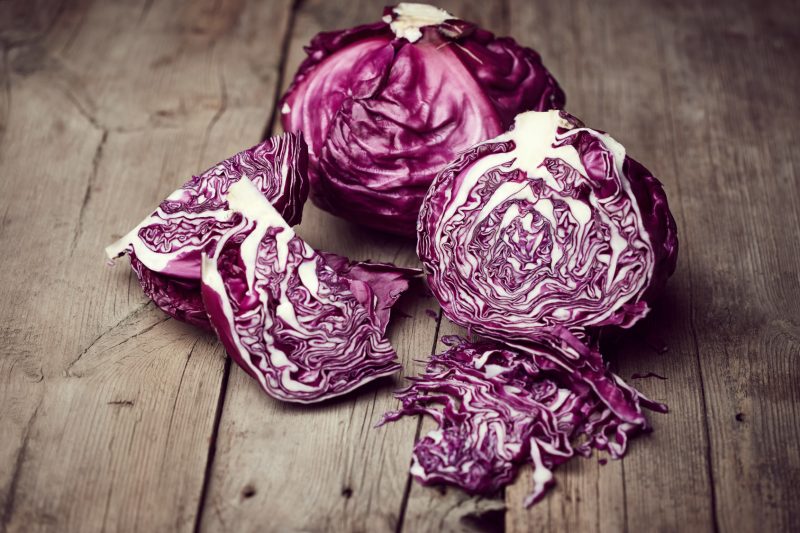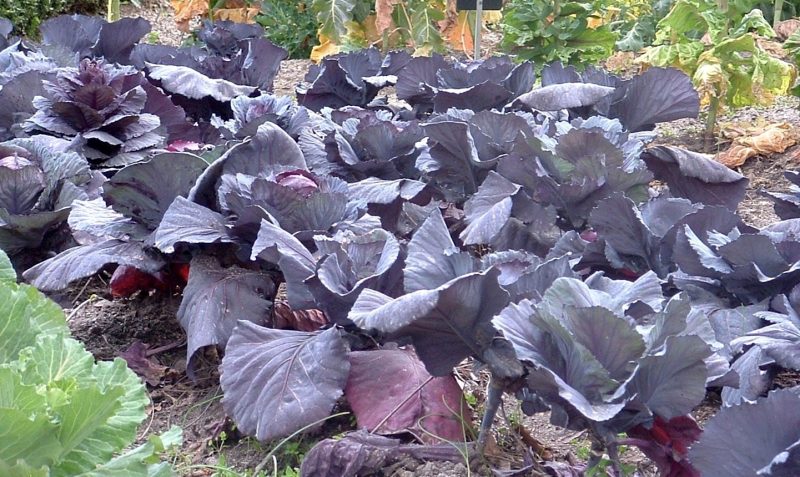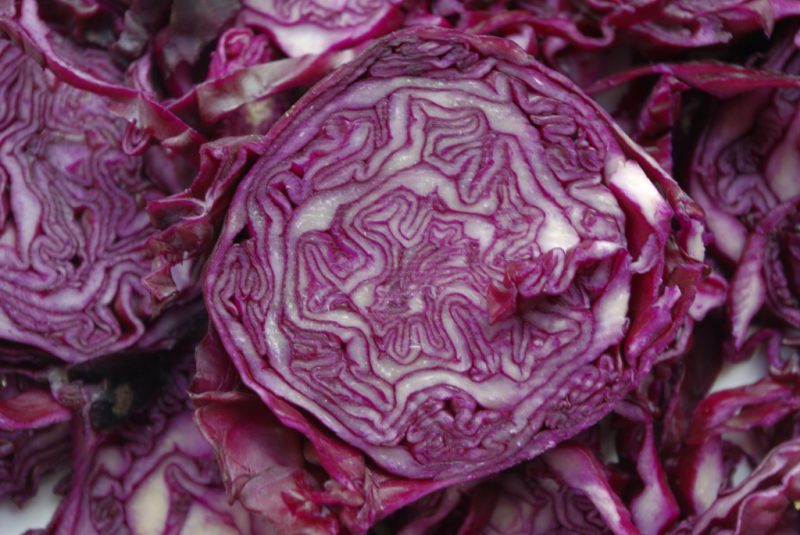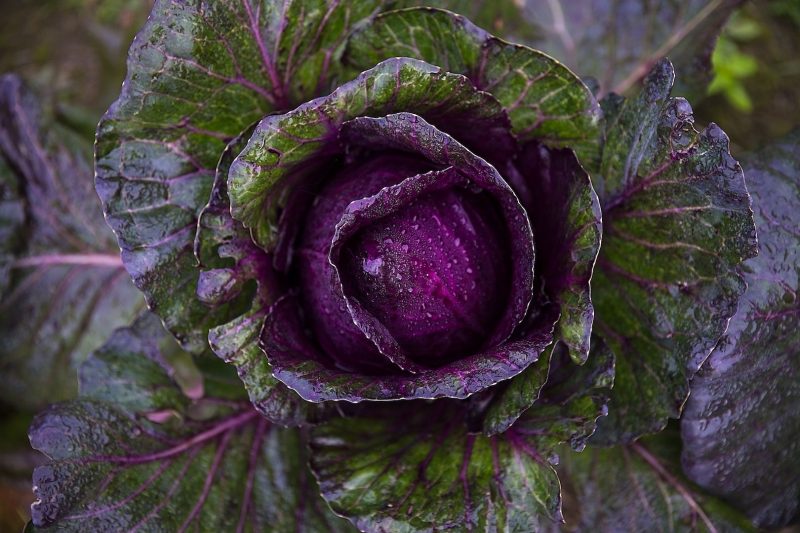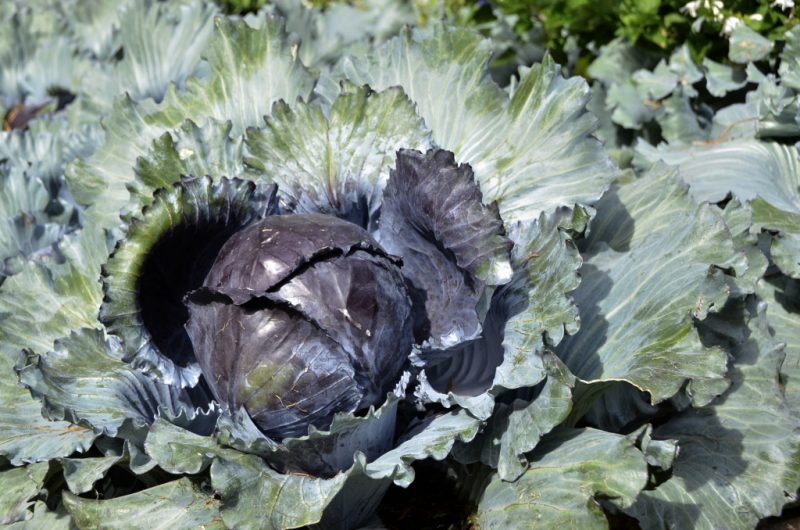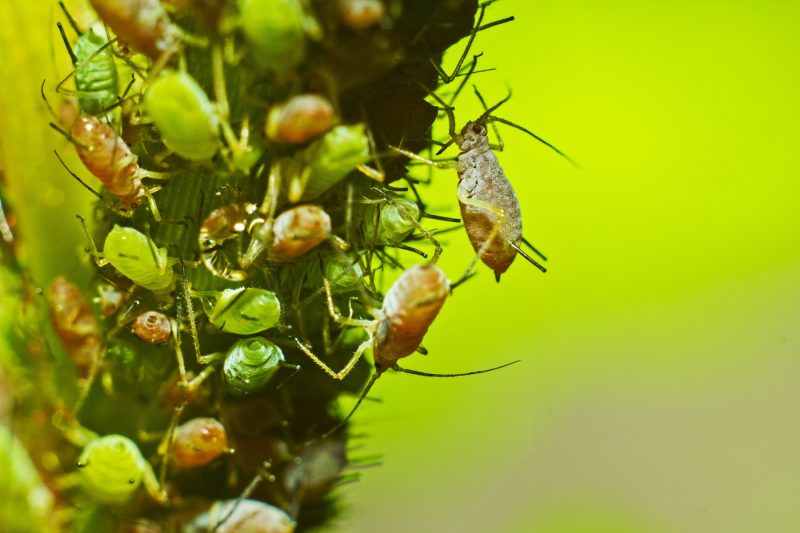Cabbage with bright, violet-red leaves attracts the eye with its unusual appearance, has a spicy taste and is a valuable source of vitamins. Stewed and pickled dishes, fresh salads and tasty preparations for the winter are prepared from this vegetable.
Observing the simple rules of care, red cabbage can be easily grown on the site and for a long time enjoy the results of their labor.
Material Content:
The origin and description of the culture
Italy is considered the birthplace of the bright plant, from there it spread to the countries of Central Europe, and in the seventeenth century it was brought to Russia.
The culture belongs to two-year-old plants of the Cruciferous family. Red cabbage is a related species of white cabbage - they are similar in structure, grown in almost the same conditions and differ only in color and flavor.
Cabbage has elastic, purple leaves with a burgundy tint and white veins on the cut, due to the content of a large amount of anthocyanin - a special substance that gives plants a bright color.
Depending on the variety, its head has a round or elongated shape and weighs from 1 to 3 kg. The root system of the cabbage is powerful, with small branches, the seeds are oval, dark brown in color.
The plant belongs to late-ripening varieties of vegetables, the period of its development and growth is about 5-6 months. Red cabbage prefers good lighting and moist, fertile soil. It is quite unpretentious, resistant to cold and can withstand even small frosts.
Chemical composition
The red vegetable contains many useful substances and has a small energy value - only 25 Kcal per 100 g of product.
It consists of:
- cellulose;
- starch;
- vegetable protein;
- carbohydrates;
- amino acids;
- vitamins: E, A, C, H, U, PP, B1, B6, B9, B2, B5;
- trace elements: calcium, iodine, magnesium, sodium, potassium, selenium, phosphorus, zinc, manganese.
Red cabbage is also rich in biologically active substances - phytoncides, which neutralize the action of pathogenic bacteria, and anthocyanins, which strengthen blood vessels and protect against free radicals.
The benefits to humans
Regular use of this vegetable favorably affects the work of all organs and systems.
The main benefits of red cabbage are as follows:
- Improves the digestive system, restores the intestinal microflora.
- It activates renal activity, helps to remove toxins and toxins.
- Normalizes the condition of the skin.
- Increases immunity.
- Helps fight leukemia, hypertension, osteoporosis.
- Improves brain activity, vision, positively affects the thyroid gland.
- It stabilizes the nervous system, normalizes sleep, and eliminates depression.
- Promotes rapid healing of cuts and wounds.
- Used during the treatment of cough with bronchitis, pneumonia, asthma.
The unique plant has a rejuvenating effect - smoothes the skin, giving it freshness. It also makes eye proteins “cleaner”, strengthens bones, teeth, nails, improves hair condition. In addition, red cabbage is a dietary product, which is why it is ideal for supporters of a healthy diet who want to keep their weight normal.
Possible contraindications
Unfortunately, some people should exclude a vegetable of this variety from their diet in order to prevent its harmful effects.
These include:
- Children under one year old.
- Women during lactation.
- People prone to food allergies.
- People taking blood thinners.
- Patients suffering from chronic diseases of the stomach and intestines.
In principle, red cabbage is quite safe, it is suitable for use by all healthy people and even patients with diabetes. The main thing is not to abuse a useful product and take into account the individual characteristics of your body.
Agrotechnical requirements for growing
In order for the cabbage to grow healthy, to have uniformly colored, juicy leaves and a normal size, it is necessary for it to choose a well-lit place where the sun's rays will penetrate.
Read also:yeast plant nutrition - recipe
It should be borne in mind that it is recommended to plant a vegetable in loose, slightly acidic soil containing nutrients.
Best of all, red cabbage grows in the beds, where legumes, potatoes, carrots, cucumbers or onions used to be.
At first, it is recommended to sow the seeds in special containers, then place them in a greenhouse, grow seedlings from them, and then transfer them to a chosen place in the garden. When a young plant begins to develop, it is necessary to regularly take care of it - to water it stably, to weed on time, to spud and to fertilize. And you should also protect the vegetable from diseases and dangerous insects.
Planting red cabbage in the open ground
Planting cabbage on the site is best done in mid spring or early summer. Before planting a crop, it is necessary to prepare the soil. To do this, you need to clean the earth, carefully dig it and add wood ash to it.
After this, you need to prepare seedlings. If it cannot be grown independently, the sprouts can be purchased in a specialized store or in the market. Ready for transplant cabbage seedlings looks like a group of 5-6 leaves, in the middle of which the rudiments of a small fork are noticeable.
For planting in open ground, it is advisable to choose the evening time, after the recent rain. Then you need to dig holes, the distance between which should be at least 10 cm. Pour some potash fertilizers at the bottom of each hole and pour plenty of water.
In each recess, it is necessary to place a cabbage sprout with a ground lump on the roots, then gently fill it with soil and lightly tamp. After this, you should well moisten the wells with seedlings with warm water.
The first two weeks you need to close the young cabbage from direct sunlight, and then accustom it to them gradually. The newly planted plant should be watered once every seven days, pouring 2 liters of water under each of them. As the vegetable grows, the volume of liquid will need to be increased, only it should be remembered that excess moisture will lead to decay of the roots, and this may cause the plant to die. Therefore, it is recommended to water it after the topsoil is completely dry.
Hilling, cultivation and top dressing
During the cultivation of cabbage, it is necessary to periodically loosen the soil to a depth of 6-8 cm, since for full development it needs land with a light texture, enriched with oxygen. The first time the procedure should be done 15-17 days after planting, and then repeat every week after watering.
Hilling red cabbage contributes to the formation of a strong head of cabbage and favorably affects the growth of the root system. Such an option for leaving the plant will be necessary during intensive growth, when cabbage rosettes begin to form. During this period, the earth needs to be poured to the first layer of leaves, and the following manipulations should be carried out every two weeks.
Varieties of red cabbage that ripen quickly should be fed twice during the growing season, and late ripe vegetables three to four times. The plant needs potash and nitrogen fertilizers, as well as calcium.
It is interesting:euphorbia mile: care
The first top dressing must be done fifteen days after planting. For one square meter, you need to take 16 g of potassium sulfate, 20 g of superphosphate and 10 g of urea. Nutrients must be poured into special grooves dug between vegetables, then bury them and moisten the entire garden well.
The next feeding should be done when the heads of cabbage begin to form, about three weeks after the previous one. In this case, the volume of fertilizers will need to be increased one and a half times. Organic substances can also be used, for example, manure diluted with water, poultry litter or a mixture of weed grass.
The remaining dressings are recommended to be done with an interval of 17 to 20 days. They should consist only of potassium and phosphorus. They must be applied dry in moist soil, 23 g per square meter, or diluted in a bucket of water and water the plants. These substances can be alternated with wood ash and complex nitrogen-free fertilizers suitable for cabbage.
Major diseases and pests
Red cabbage is less susceptible to disease and pest attacks, unlike white cultivars.
But still, it can suffer from fungal infections, such as:
- Dry rot. The most common disease in which the cabbage stalk becomes loose, acquires a dark shade and dries. The fungus provokes constant waterlogging of the soil, those parts of the plant that are damaged are especially affected. If dry rot affects seedlings, then it is impossible to cure it. To get rid of negative manifestations, it is necessary to treat the seeds with Tigama solution (0.5%) before sowing and timely remove weed grass around the planted vegetables.
- Kila. A very dangerous disease that leads to the death of the root system of the plant. It manifests itself in the form of large tumors on the roots, because of which the cabbage will not be able to receive good nutrition.There is only one way to combat this fungus - regularly get rid of weeds and plant cabbage in the ground, where a culture has grown that contributes to the destruction of pathogenic spores.
- Black spotting. It appears in the form of dark gray spots, gradually capturing all the leaves of the vegetable. The reasons for the appearance of the fungus are too dense planting, a high percentage of humidity and warm weather. To avoid this scourge, it is necessary to plant vegetables at a distance from each other and not to overdo it with watering. To combat the disease, a solution of potassium permanganate (5g per 10 liters of water) is suitable, which needs to be treated several times.
The main pests of red cabbage include:
- Aphid. Small insects parasitizing in large clusters on the inside of the sheets. From this, they curl, lose color and dry out. You can destroy harmful insects with a decoction of stems and leaves of a tomato. They must be filled with water and boiled for twenty minutes. Then dilute three liters of the resulting liquid with clean water (10 l), add 25 g of laundry soap and spray the vegetables.
- Cabbage fly. This parasite lays larvae that damage the root system of the plant, and as a result, it gradually dries up. To prevent insects from appearing, it is necessary to introduce Bazudin (20 g per 9 square meters of soil) into the ground.
- Cabbage Moth. It looks like a yellow caterpillar that eats cabbage leaves inside, leaving their upper part untouched. Here you need to use "Karbofos" (60 g per bucket of water). They need to process vegetables several times. It should be borne in mind that the tool is quite toxic, therefore, one month before harvesting it can not be used.
In order to prevent pests from attacking, in early spring the cabbage bed should be watered with insecticides, for example: Fufanon, Tiovit, Alatar or ordinary boiling water. With a small accumulation of insects, it is recommended to process vegetables with folk remedies: soapy water, red pepper infusion, colloidal sulfur, as well as soda diluted in water.
Thanks to competent care and attention, you can get bright, tasty and healthy cabbage, dishes from which diversify the daily menu and decorate the table set for a special occasion.


